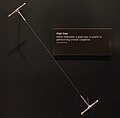Gigli saw
Gigli saw is a flexible wire saw used in surgery to cut through bone. It was invented by Leonardo Gigli, an Italian surgeon, in the early 20th century. The saw is made of a series of sharp teeth on a flexible wire. It is used in conjunction with two T-shaped handles that allow the surgeon to control the direction and pressure of the cut.
History[edit]
The Gigli saw was invented by Leonardo Gigli, an Italian surgeon, in the early 20th century. Gigli was looking for a way to make surgical cuts in bone that were both precise and minimally invasive. He developed the Gigli saw as a solution to this problem.
Design[edit]
The Gigli saw is made of a flexible wire with a series of sharp teeth. The wire is typically made of stainless steel or a similar durable material. The teeth of the saw are designed to cut through bone without causing excessive damage to the surrounding tissue.
The saw is used in conjunction with two T-shaped handles. These handles allow the surgeon to control the direction and pressure of the cut. The handles are typically made of a durable material like stainless steel or plastic.
Uses[edit]
The Gigli saw is used in a variety of surgical procedures that require cutting through bone. These include craniotomy, a procedure in which a portion of the skull is removed to access the brain; limb amputation, in which a limb is removed; and osteotomy, a procedure in which a bone is cut to correct a deformity.
The saw is also used in autopsy procedures to open the skull and access the brain.
Advantages and Disadvantages[edit]
The main advantage of the Gigli saw is its ability to make precise cuts in bone with minimal damage to the surrounding tissue. This makes it an ideal tool for procedures that require a high degree of precision.
However, the saw also has some disadvantages. It can be difficult to control, especially in tight spaces. It can also cause injury if not used properly.
See Also[edit]
Ad. Transform your life with W8MD's Budget GLP-1 injections from $75


W8MD offers a medical weight loss program to lose weight in Philadelphia. Our physician-supervised medical weight loss provides:
- Weight loss injections in NYC (generic and brand names):
- Zepbound / Mounjaro, Wegovy / Ozempic, Saxenda
- Most insurances accepted or discounted self-pay rates. We will obtain insurance prior authorizations if needed.
- Generic GLP1 weight loss injections from $75 for the starting dose.
- Also offer prescription weight loss medications including Phentermine, Qsymia, Diethylpropion, Contrave etc.
NYC weight loss doctor appointmentsNYC weight loss doctor appointments
Start your NYC weight loss journey today at our NYC medical weight loss and Philadelphia medical weight loss clinics.
- Call 718-946-5500 to lose weight in NYC or for medical weight loss in Philadelphia 215-676-2334.
- Tags:NYC medical weight loss, Philadelphia lose weight Zepbound NYC, Budget GLP1 weight loss injections, Wegovy Philadelphia, Wegovy NYC, Philadelphia medical weight loss, Brookly weight loss and Wegovy NYC
|
WikiMD's Wellness Encyclopedia |
| Let Food Be Thy Medicine Medicine Thy Food - Hippocrates |
Medical Disclaimer: WikiMD is not a substitute for professional medical advice. The information on WikiMD is provided as an information resource only, may be incorrect, outdated or misleading, and is not to be used or relied on for any diagnostic or treatment purposes. Please consult your health care provider before making any healthcare decisions or for guidance about a specific medical condition. WikiMD expressly disclaims responsibility, and shall have no liability, for any damages, loss, injury, or liability whatsoever suffered as a result of your reliance on the information contained in this site. By visiting this site you agree to the foregoing terms and conditions, which may from time to time be changed or supplemented by WikiMD. If you do not agree to the foregoing terms and conditions, you should not enter or use this site. See full disclaimer.
Credits:Most images are courtesy of Wikimedia commons, and templates, categories Wikipedia, licensed under CC BY SA or similar.
Translate this page: - East Asian
中文,
日本,
한국어,
South Asian
हिन्दी,
தமிழ்,
తెలుగు,
Urdu,
ಕನ್ನಡ,
Southeast Asian
Indonesian,
Vietnamese,
Thai,
မြန်မာဘာသာ,
বাংলা
European
español,
Deutsch,
français,
Greek,
português do Brasil,
polski,
română,
русский,
Nederlands,
norsk,
svenska,
suomi,
Italian
Middle Eastern & African
عربى,
Turkish,
Persian,
Hebrew,
Afrikaans,
isiZulu,
Kiswahili,
Other
Bulgarian,
Hungarian,
Czech,
Swedish,
മലയാളം,
मराठी,
ਪੰਜਾਬੀ,
ગુજરાતી,
Portuguese,
Ukrainian




